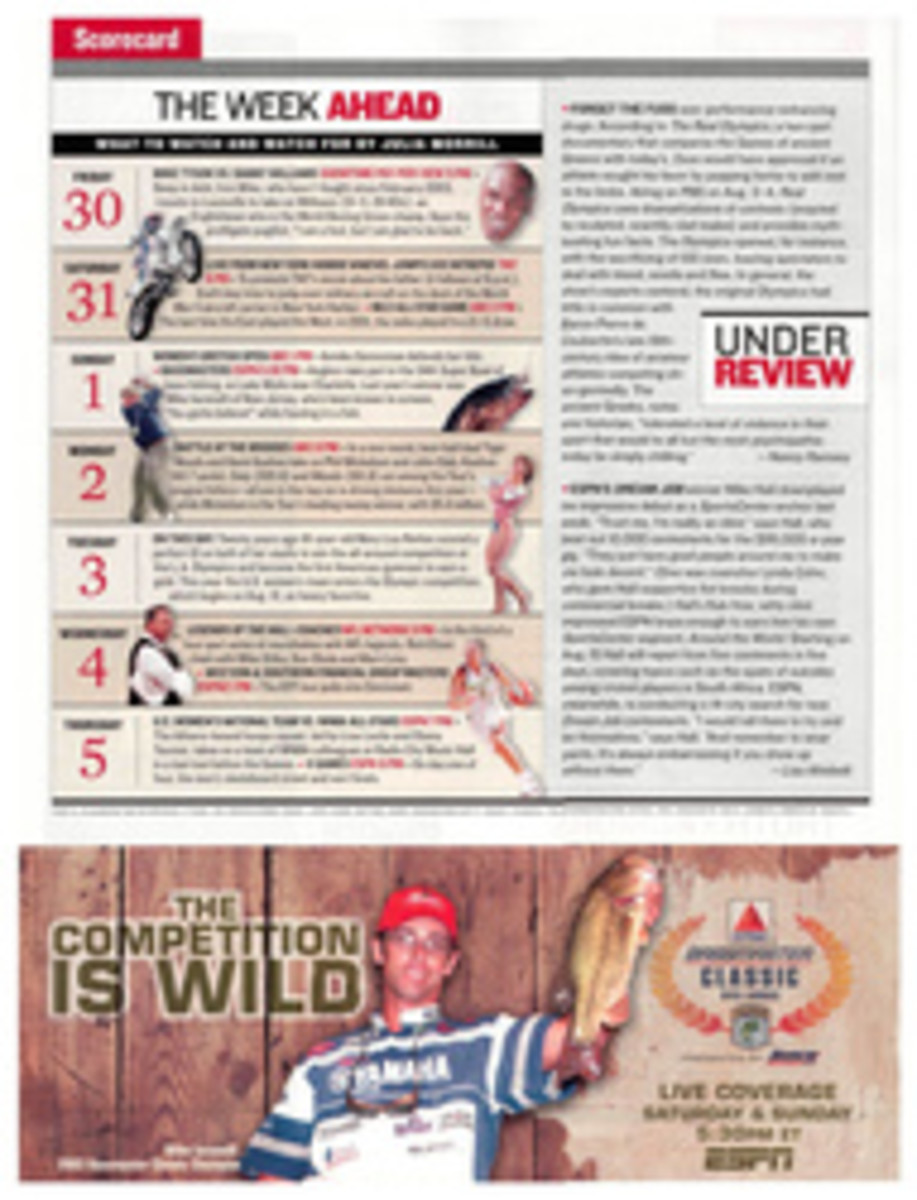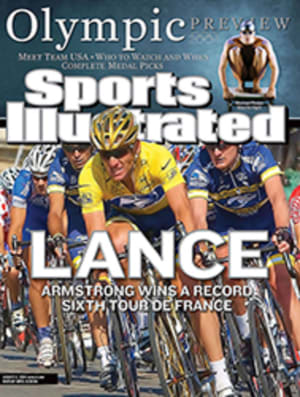
Maurice Greene ONE MO' TIME His sport is a colossal mess, but the 2000 gold medalist is back in fine form, raring to prove he's the best 100-meter runner ever
Here at last was the perfect race, unfolding beneath his feet. It
was a summer night in Edmonton at the 2001 World Track and Field
Championships, and Maurice Greene was hurtling toward some place
divine. Already an Olympic gold medalist, twice a world champion,
the reigning world-record holder and certain to be remembered as
one of the best 100-meter runners in history, Greene had nailed
his start, risen into a full sprint and now, 60 meters down the
track, could feel that this was the race in which all the pieces
would fall into place. "The winning time," says Greene, "was
going to be something that would be imprinted on people's minds."
Then came the pain in his left thigh, a twinge and then a stab.
He hobbled sideways across the finish line, dragging his injured
leg, barely in front of the fast-closing Tim Montgomery. Greene
was again the world champion, and his time (9.82 seconds into a
modest headwind) was then the third fastest in history. Still,
the race felt to him like an opportunity lost.
Those were fast days for Greene, when speed came easy, like
breathing fresh air. "Maurice and I used to joke about falling
out of bed and running sub-9.90," says Ato Boldon of Trinidad and
Tobago, Greene's longtime training partner with the Los
Angeles-based HSI sprint group. "It was easy, and we took it for
granted. It becomes part of who you are, and when it's gone, it's
lonely."
It seemed as though there would be another day for Greene, but
instead there were three empty years. There was death in his
family, the dissolution of a shoe company relationship that left
him feeling unwanted, and a mysterious accident on a Los Angeles
freeway that left him with a broken leg. There were plodding
times and dark, funny lines; British sportswriters dubbed him
Slo-Mo. Many track observers accepted that the Greene era in
sprinting was over. Five years, plenty of battles, job well done.
Exit, stage left.
Yet there was Greene on the second Sunday in July, 12 days shy of
his 30th birthday, winning the 100 meters in 9.91 seconds at the
U.S. Olympic Trials in Sacramento by outgunning brilliant young
sprinters Justin Gatlin (9.92) and Shawn Crawford (9.93) in a
thrilling blanket finish. Greene had been good all spring, but at
the trials he strung together four superb rounds of 100s--"The
best series of my life," he said on the morning after the
final--reestablishing himself as the best big-race sprinter in
the world. He had screamed an obscenity after crossing the finish
line. "I acted a fool out there for a minute," he said. "But I
had something to prove."
A gold medal in Athens would solidify Greene's claim to be the
greatest 100-meter runner ever. Greene has four of the five
fastest times in history, and he would join Carl Lewis (1984 and
'88) as the only back-to-back Olympic 100 champs. Some voices
already proclaim Greene the best, including his own: He has a
tattoo on his right biceps that reads G.O.A.T., for Greatest of
All Time. "In the 100 meters he is the greatest, hands down,"
says Michael Johnson, who holds that same distinction--and the
world records--at both 200 and 400 meters.
Defending his Olympic title will not be easy for Greene, however.
If not for an ill-timed lean in Sacramento, Gatlin might have
beaten him, and Crawford appears to have the best top-end speed
in the world, though he has yet to piece together an entire race.
"Maurice doesn't make mistakes," says Trevor Graham, who coaches
Gatlin and Crawford.
Greene will be running in the vortex of the sport's ongoing drug
scandal, in a world where running fast is ever more likely to
create suspicion. During the trials it was reported that three
HSI athletes had tested positive for banned substances this
spring: women's world 100-meter champion Torri Edwards (who
admitted taking a banned stimulant but claimed it was
inadvertent; at week's end track's international governing body
was considering whether or not to suspend her), sprinter Mickey
Grimes (who reportedly tested positive for steroids; he has not
commented) and one of Greene's best friends, hurdler Larry Wade
(also positive for steroids; his representatives say they plan to
challenge the test result). Throughout his career Greene has
repeatedly denied using performance-enhancing drugs. In Athens he
will be asked to do so again.
Greene has been through more trying ordeals than that over the
last three years. The injury suffered in Edmonton ended his
season and sent him reeling into a miserable autumn and winter
marked by tragedy. First came the death of his grandmother
Elizabeth Greene, with whom he had stayed every afternoon after
school in Kansas City, Kans., while waiting for his parents to
get off work. Then two of his uncles died.
His breakup with Nike came soon thereafter. Greene had had an
endorsement contract with the company since 1995 and was one of
its highest-paid track and field athletes, but his deal ran out
at the end of 2001. In negotiations for a new contract Greene and
his manager, Emanuel Hudson, asked Nike for a raise, a series of
three television commercials promoting Greene, and a shoe named
after him that would be sold to the public. "We were close on the
dollars," says Greene. "But on the other two, Nike just said no.
That's it. No. I felt as if we had a better relationship than
that, like family. It hurt."
John Capriotti, global director of Nike running, says, "I've
known Maurice since he was a little kid, but I can't comment on
this."
Johnson, who was also aligned with Nike throughout his career,
says, "Yes, Maurice is the best ever in the 100. But he's not the
kind of athlete who does something special, beyond the ordinary,
like Marion Jones winning five medals in Sydney or me winning the
200 and 400 in Atlanta. He thinks he is, but he's not."
Hudson subsequently negotiated a lucrative deal with Adidas, but
the switch in companies not only bruised Greene's ego but also
interrupted his considerable cash flow. While negotiating with
Nike, he was preparing to break ground on a new house in Simi
Valley, Calif. "The builder was asking for money every day," says
Greene. Ultimately, instead of building a new one, Greene bought
a $2.4 million house in that same community.
A new shoe sponsor meant new custom shoes, and for nearly two
years Greene ran in stylish Adidas spikes that, he says, hurt his
feet and hindered his performance. "Now after working with Adidas
for two years," he says, "we've got a great shoe."
It was in January 2002 that Greene says he was sideswiped by a
minivan on the southbound 405 freeway while riding his new Suzuki
600-cc motorcycle to practice. The low-speed collision, according
to Greene, caused a small fracture at the top of the fibula in
his left leg. He didn't publicly disclose the injury--or the
crash--until two months ago, fearing that it would have weakened
his negotiating position with Nike. In addition, says Greene, "I
didn't want to be making excuses if I ran slow."
Greene did, in fact, run slowly, for two years. Every good race
was followed by three poor ones. In September 2002 he was in the
stands when Montgomery (who is facing a lifetime ban by the U.S.
Anti-Doping Agency for his alleged use of steroids and other
drugs) broke Greene's 1999 world record of 9.79 seconds by
running 9.78 in Paris. Last summer at the worlds, also in Paris,
the 5'9" Greene was eliminated in the semifinals, and he shut
down for the year, fighting new pains in his right knee and
slogging around at 190 pounds, 15 more than his ideal weight. He
took nearly two months off, waiting for training to begin with
HSI coach John Smith. But Greene started ahead of schedule,
running with Wade on the sand along Venice Beach and up the
stairs leading from the water to the Pacific Coast Highway in
Santa Monica. "I didn't feel any pain," says Greene. "Then I knew
I was going to be back."
Smith, Greene's coach since 1996, says, "I've seen Maurice grow
up. He's a mature person and a mature sprinter." It is possible
that Greene will never again be the dominant sprinter who won the
Sydney gold medal by daylight and ran under 9.90 seconds nine
times, which is more than any other runner in history. "That guy
who crushed us all in Sydney, I don't think he can show up
again," says Boldon. "I think he died in that motorcycle
accident. But Maurice can still complete a race."
In March, Greene blasted from the blocks in the 60 meters at the
U.S. indoor championships, felt a twinge in his right hamstring
and pulled up. Before the twinge he had run 40 meters, and they
had felt as perfect as those first 60 in Edmonton had three years
earlier. He ran to his coach, Smith, and said, excitedly,
"Johhhhn.... They can't hold me anymore." The hamstring healed,
and Greene lost just once outdoors in 2004 before winning at the
trials.
In Sacramento, in the painful two hours between the semifinals
and the final of the 100, Smith approached Greene on the warmup
track and warned him, "You're getting close to something big
here, and the last time that happened was Edmonton, and you
rushed yourself and got hurt. Be patient. Take your time."
In Athens that will not be easy. Greene feels himself close to
something again. To another gold medal. To reclaiming his world
record. To cleaning up unfinished business. "I was on a path to
something unbelievable," says Greene. "Now I'm on that path
again."
COLOR PHOTO: PHOTOGRAPH BY MICHAEL O'NEILL Although he has been plagued by injuries and no longer holds theworld record in the 100, the 30-year-old Greene won the U.S.trials and will be a favorite in Athens.
COLOR PHOTO: BILL FRAKES Training partners Gaitlin (left) and Crawford will challengeGreene in the 100.

